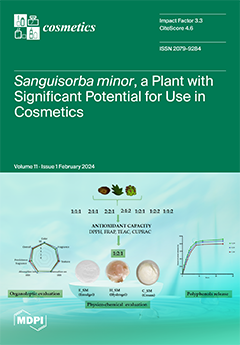There has been a significant increase in the use of botanical resources for the formulation of topical products designed for medicinal and cosmetic applications.
Sanguisorba minor Scop., a botanical species, exhibits a variety of properties and has significant potential for applications in the
[...] Read more.
There has been a significant increase in the use of botanical resources for the formulation of topical products designed for medicinal and cosmetic applications.
Sanguisorba minor Scop., a botanical species, exhibits a variety of properties and has significant potential for applications in the field of cosmetics. The aim of this study was to formulate topical preparations, incorporating an extract derived from the plant
S. minor Scop. comprising a combination of roots, leaves, and flowers. In the initial phase, a total of seven combinations were prepared using extracts derived from the roots, leaves, and flowers of
S. minor Scop. (
v/
v/
v). These combinations were subsequently subjected to evaluation for their antioxidant capacity using four distinct methods: 2,2-diphenyl-1-picrylhydrazyl (DPPH), ferric reducing antioxidant power (FRAP), cupric reducing antioxidant capacity (CUPRAC), and Trolox equivalent antioxidant capacity (TEAC). An extract of plant organs in a ratio of 1:2:1 (
v/
v/
v), which had a strong antioxidant capacity and demonstrated synergistic effects according to the DPPH, TEAC, and CUPRAC assays (with values of 1.58 ± 0.1, 1.18 ± 0.09, and 1.07 ± 0.07, respectively), was selected for inclusion in three dermato-cosmetic products (hydrogel, emulgel, and cream). All the prepared preparations were evaluated in terms of topical formulation attributes and organoleptic characteristics. The testing of dermato-cosmetic products included assessments of their topical formulation properties and organoleptic characteristics. The hydrogel, emulgel, and cream exhibited varying degrees of stretchability. In addition, a study was carried out to assess the in vitro release of polyphenols from the cosmetic formulations using a Franz diffusion cell system. The results showed that the emulgel containing the extract of
S. minor Scop. had the highest and most significant release of polyphenols, with a release rate of 84.39 ± 1.01%. This was followed by the hydrogel and cream, which had release percentages of 80.52 ± 0.89 and 75.88 ± 0.88, respectively, over an 8 h period. Thus, for the first time in the literature, a topical cosmetic product with high antioxidant potential containing
S. minor Scop. extract was developed and optimized.
Full article





